Today is the second tutorial in the Back to Basics Cold Process Series. Now that we have made a basic recipe with coconut oil, palm oil and olive oil, we are adding cocoa butter into the mix! The addition of cocoa butter adds to the firmness of the bar. It also causes the soap batter to reach a thick trace more quickly. In addition, 10X Orange Essential Oil is added to give this soap a beautiful, natural orange color. The Back to Basics Soapmaking Kit includes all the soaping ingredients you need to create all four recipes in this series, including the 10″ Silicone Mold. Now, let’s get soaping!
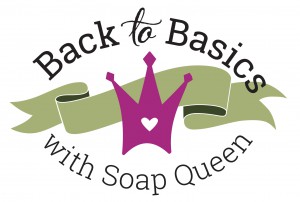
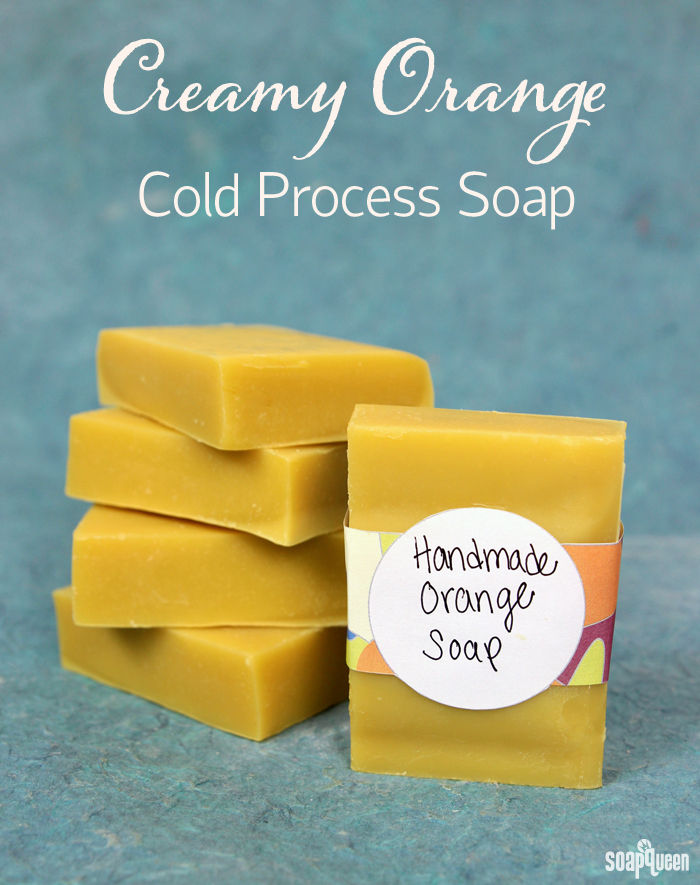 The soap bands shown above are included in the Back to Basics Kit!
The soap bands shown above are included in the Back to Basics Kit!
One of the most best parts of soap making is trying out different oils and butters. It’s interesting to see how various oils and butters affect trace and the final product. There are so many soaping oils, it can take a few batches to find “the perfect bar” for you. Everybody likes different soap properties (cleansing, moisturizing, exfoliating, etc), so it’s fun to experiment! This recipe is comprised of coconut oil, palm oil, olive oil and cocoa butter. To learn more about properties of common soap making oils, check out this blog post.
The coconut oil, palm oil and cocoa butter contribute to the firmness of the bar. A large percentage of olive oil is used to give the bar softness. In addition to firmness, coconut oil also gives the bar a lush lather and cleansing properties. Cocoa butter is used at 10% for firmness and for its skin loving properties. Cocoa butter is a stable fat and also contains natural antioxidants, making it a popular choice for cold process recipes. Read more about it in this Sunday Night Spotlight.
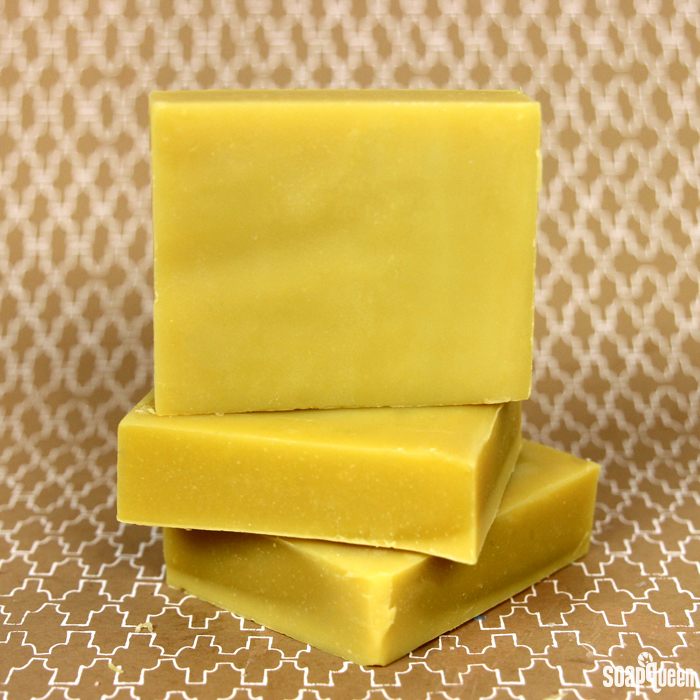
Use cocoa butter at 15% or less in cold process soaps; any higher than than can cause cracking in your final bar. Because of its naturally chocolatey scent, cocoa butter can hide some delicate fragrances, like florals. This is important when working with more faint or delicate fragrances. The cocoa butter will cause this recipe to reach trace and become thicker faster than some recipes. Keep this in mind when stick blending! Because of their ability to thicken trace, butters are an excellent addition for designs with layers and textured tops. Finally, cocoa butter has a higher melt point than other oils in this recipe so keeping to the warmer end of the temperature range is helpful to keeping it fully workable the entire process.
This recipe contains a 5% superfat. This means that 5% of the oils in this recipe were not turned into soap, and are “free floating” in the soap. In other words, this recipe contains 5% less lye than necessary to turn 100% of the oils into soap. Learn more about superfatting soap in this blog post.
Creamy Orange Cold Process Soap Recipe (Superfat 5%)
13.6 oz. Olive Oil (40%)
8.5 oz. Palm Oil (25%)
8.5 oz. Coconut Oil (25%)
3.4 oz. Cocoa Butter (10%)
4.8 oz. Sodium Hydroxide Lye
11.2 oz. Distilled Water
2 oz. 10X Orange Essential Oil
This tutorial is the second in the Back to Basics Cold Process Series. This series of tutorials includes four cold process recipes that are perfect for beginning soapers. The Back to Basics Soapmaking Kit includes all the soaping ingredients you need to create all four recipes, including the 10″ Silicone Mold. The only ingredient you need to buy separately is lye, and any tools you may need. A great way to receive the basic soaping tools is with the Beginner’s Soaping Tool Kit, or click the “Buy it Now” button for the tools necessary for this project, lye and kit to your cart to your cart separately.

Click here to add everything you need for this project to your Bramble Berry shopping cart!
If you’ve never made Cold Process soap before, stop here! I highly recommend checking out our FREE four part SoapQueen.tv series on Cold Process Soapmaking, especially the episode on lye safety. And if you’d rather do some reading, Bramble Berry carries a wide range of books on the topic, including my newest book, Soap Crafting. You can also checkout the digital downloads for that instant gratification factor. I also recommend reviewing the first blog post in this series, which is all about how to handle lye safely.
Prepare your Mold: For this recipe, we are going to use a box rather than a mold. To turn any box into a soap making mold, it first needs to be lined with freezer paper. Freezer paper is heavy duty and durable, and has one side that is shiny. This side needs to be facing up. Learn how to line molds including recycled boxes in this blog post. In particular, we are using a USPS Medium Flat Rate Box. The inside dimensions are 11″ x 8-1/2″ x 5-1/2″.
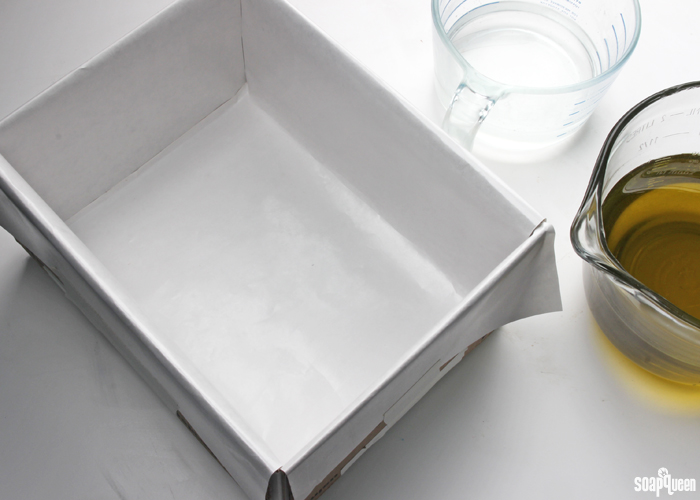 Set Up Your Area: Before soaping, it’s helpful to have your soaping area prepared before you start. While soaping, you don’t want to be running around looking for a spatula or whisk! Because this recipe does not have any complicated designs, the tools are minimal. But you will need your fully lined mold, prepared lye water, pre-mixed oils, stick blender, and a spatula. Check out the Soapy Session Preparation and Setup Guide for tips.
Set Up Your Area: Before soaping, it’s helpful to have your soaping area prepared before you start. While soaping, you don’t want to be running around looking for a spatula or whisk! Because this recipe does not have any complicated designs, the tools are minimal. But you will need your fully lined mold, prepared lye water, pre-mixed oils, stick blender, and a spatula. Check out the Soapy Session Preparation and Setup Guide for tips.
SAFETY FIRST: Suit up for safe handling practices! That means goggles, gloves and long sleeves. Make sure kids, pets, and other distractions and tripping hazards are out of the house or don’t have access to your soaping space. Always soap in a well-ventilated area.
ONE: Slowly and carefully add the lye to the water and gently stir until the lye has fully dissolved and the liquid is clear. Set aside to cool.
TWO: Combine the correct weights of coconut oil, olive oil, cocoa butter and palm oil (remember to fully melt then mix your entire container of palm oil before portioning). Allow the lye water and the oils to cool to 130°F or below (and are ideally within 10 degrees of each other). For this recipe, both the oils and lye were around 120°F.
If you’d like a harder bar of soap that releases faster from the mold, you can add sodium lactate to the cooled lye water. Use 1 teaspoon of sodium lactate per pound of oils in the recipe. For this recipe, you’d add about 2 tsp. sodium lactate.
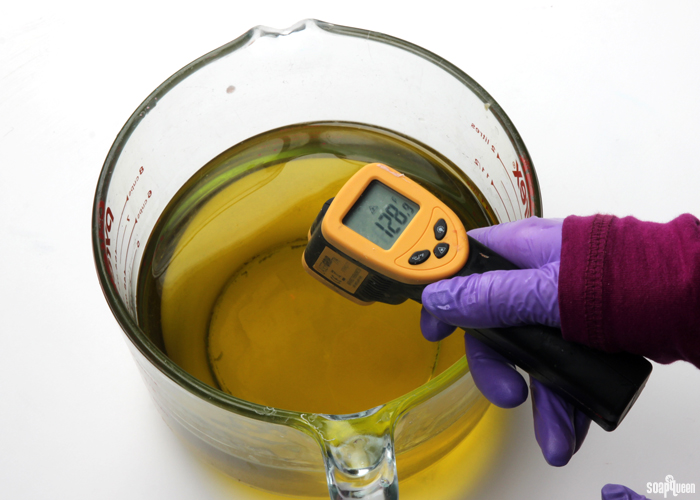
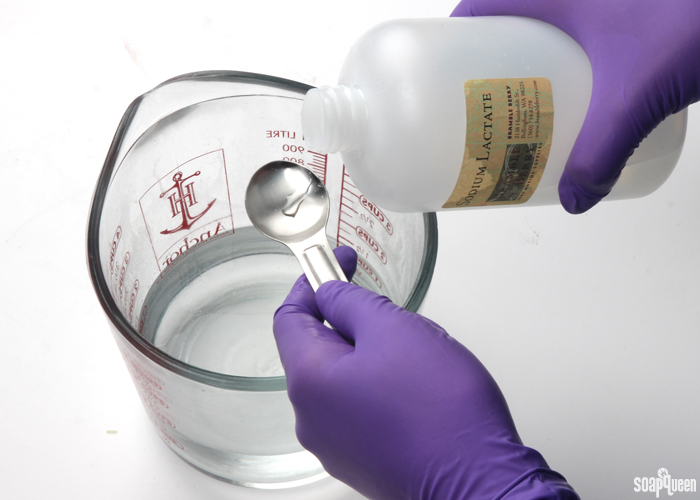
THREE: Place your stick blender into the oils. Gently tap the blender on the bottom of the bowl several times to release any bubbles that got trapped by the stick blender head. This is called, “burping the stick blender.”
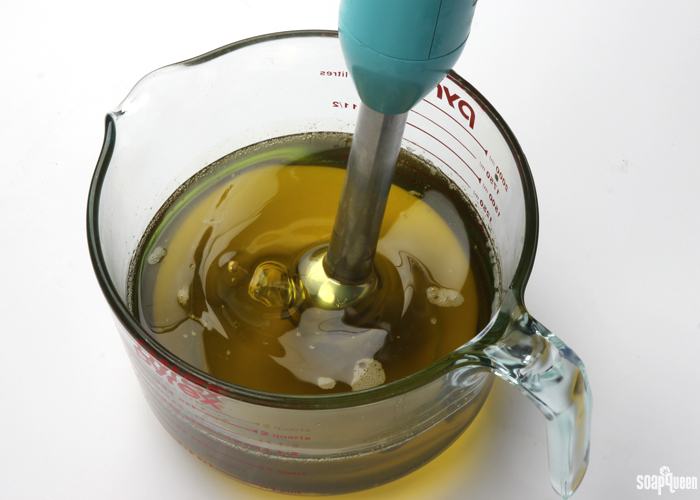 FOUR: Once bubbles no longer rise to the surface of the oils, gently pour the cooled lye water down the shaft of the stick blender and into the oils.
FOUR: Once bubbles no longer rise to the surface of the oils, gently pour the cooled lye water down the shaft of the stick blender and into the oils.
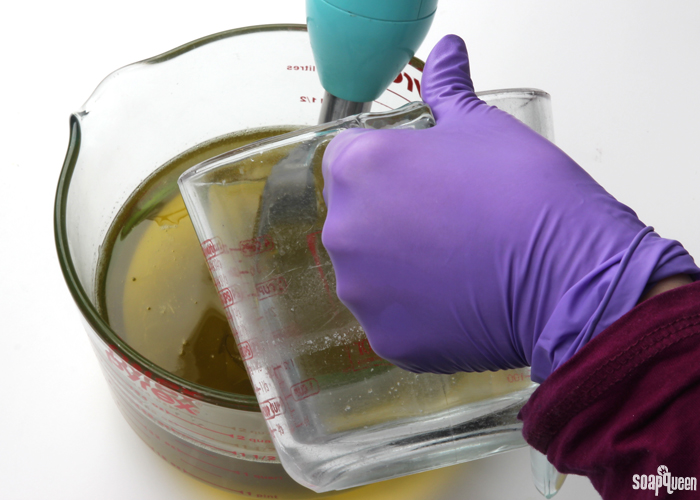 FIVE: Turn on the stick blender and pulse several times. You will immediately see the lye and oils begin to come together, and begin to create a creamy yellow color. As you continue to mix, the color will become lighter. Alternate between using the stick blender to stir the mixture, and pulsing the stick blender.
FIVE: Turn on the stick blender and pulse several times. You will immediately see the lye and oils begin to come together, and begin to create a creamy yellow color. As you continue to mix, the color will become lighter. Alternate between using the stick blender to stir the mixture, and pulsing the stick blender.
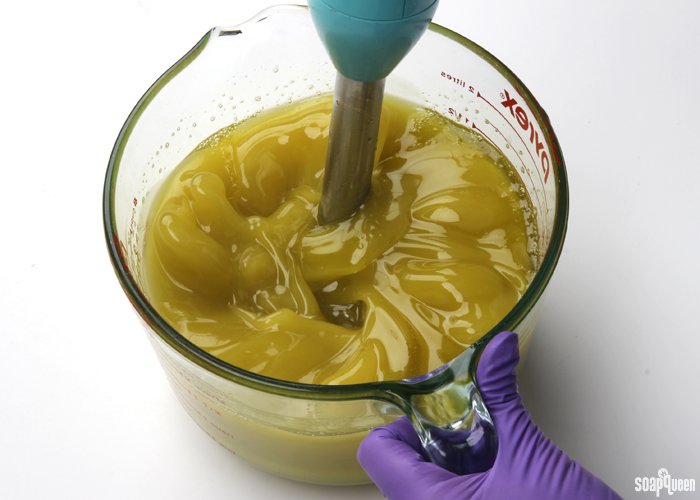
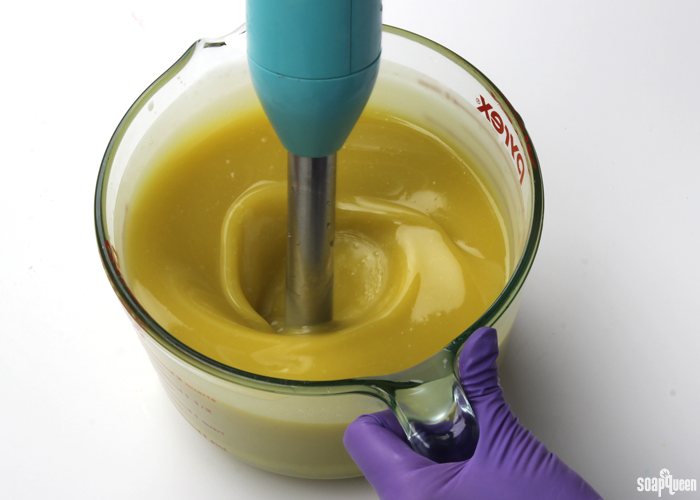
SIX: After about 30 seconds, test for trace. Because this recipe contains 10% cocoa butter, it will begin to thicken more quickly than recipes that do not contain butters, or have a high amount of liquid oil. To test for trace, lift the stick blender up and out of the batter, and “drizzle” soap on top. If the drizzles of soap are slightly supported on top of the batter, this is a thin trace. Be sure to also check the sides of the bowl; you want to make sure you see no streaks of oil within the mixture.
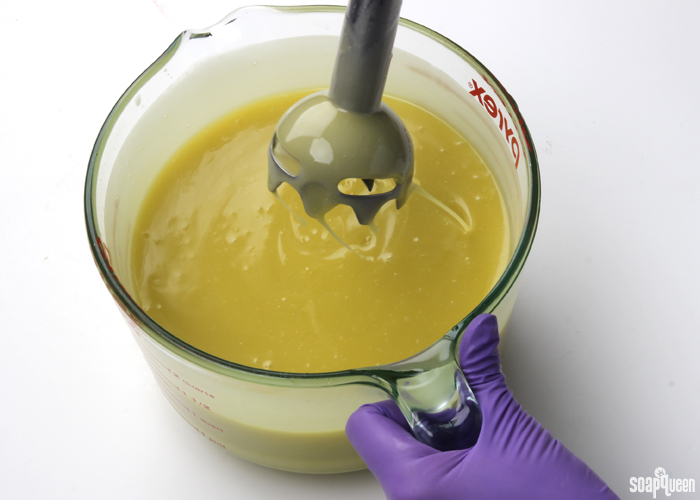 SEVEN: Once you have reached a thin trace, add all the 10X Orange Essential Oil and gently mix in with a whisk. You will notice the color of the soap batter to change into a beautiful orange color immediately. Note that 10X Orange Essential oil has been specially re-distilled so that the scent lasts in soap. Normal Orange Essential Oil will not retain its scent with cold process soap recipes.
SEVEN: Once you have reached a thin trace, add all the 10X Orange Essential Oil and gently mix in with a whisk. You will notice the color of the soap batter to change into a beautiful orange color immediately. Note that 10X Orange Essential oil has been specially re-distilled so that the scent lasts in soap. Normal Orange Essential Oil will not retain its scent with cold process soap recipes.
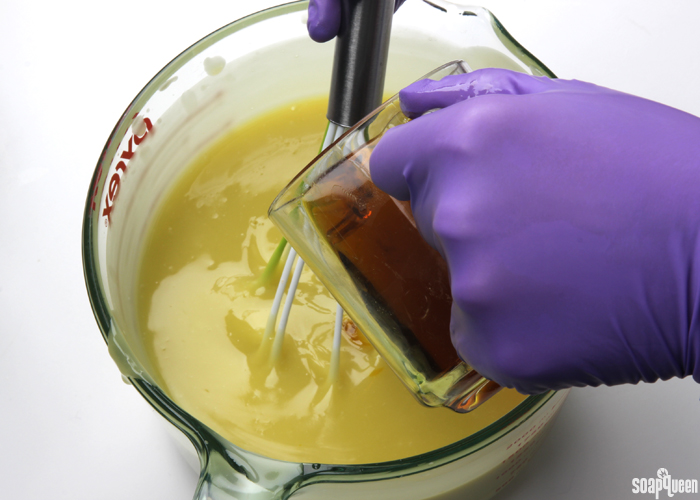
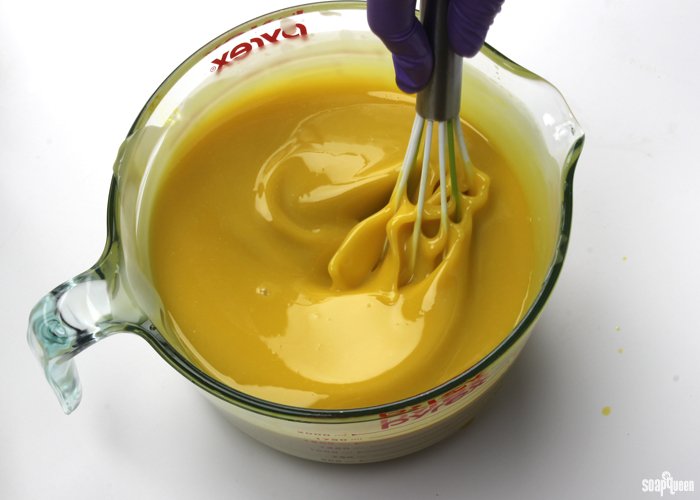 EIGHT: Once the essential oil is mixed in, pulse the mixture a few more times with the stick blender until you reach a medium trace. Below, you can see that the soap is fairly thick, and supports itself on top of the mixture. This is a great example of medium trace. For even more examples of trace, check out this blog post.
EIGHT: Once the essential oil is mixed in, pulse the mixture a few more times with the stick blender until you reach a medium trace. Below, you can see that the soap is fairly thick, and supports itself on top of the mixture. This is a great example of medium trace. For even more examples of trace, check out this blog post.
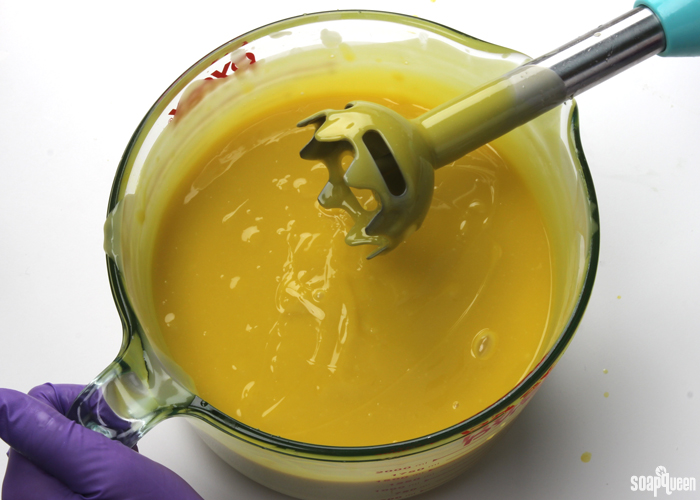 NINE: Pour the soap into the lined mold, scraping the sides of the bowl with a spatula to get all the soap into the mold. Tap the mold on the counter firmly to help eliminate air bubbles. Make sure you still have your goggles on! Sometimes soap can jump up during this process. =)
NINE: Pour the soap into the lined mold, scraping the sides of the bowl with a spatula to get all the soap into the mold. Tap the mold on the counter firmly to help eliminate air bubbles. Make sure you still have your goggles on! Sometimes soap can jump up during this process. =)
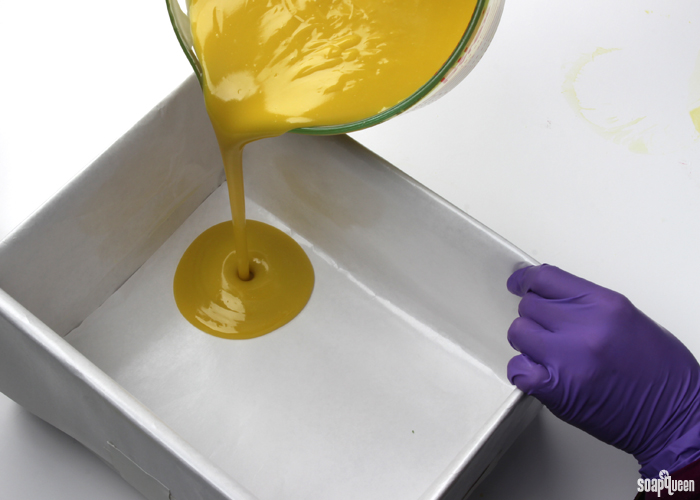 TEN: Spray the top of the soap with 99% isopropyl alcohol. Doing so helps to prevent soda ash from forming. Allow the soap to sit in the mold for 3-4 days. Unmold, and cut into bars. Allow the soap to cure for 4-6 weeks. During this time, the soap becomes more mild and water evaporates from the soap making it firmer and longer lasting in the shower. The soap can be used before the full cure time, but will not last as long. It’s best to wait!
TEN: Spray the top of the soap with 99% isopropyl alcohol. Doing so helps to prevent soda ash from forming. Allow the soap to sit in the mold for 3-4 days. Unmold, and cut into bars. Allow the soap to cure for 4-6 weeks. During this time, the soap becomes more mild and water evaporates from the soap making it firmer and longer lasting in the shower. The soap can be used before the full cure time, but will not last as long. It’s best to wait!
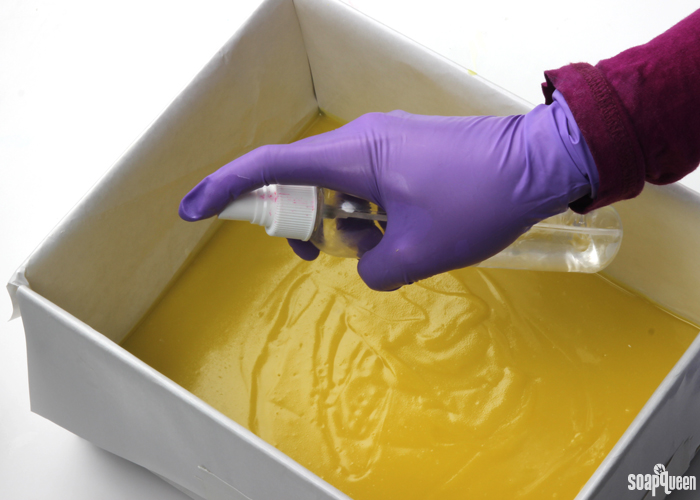
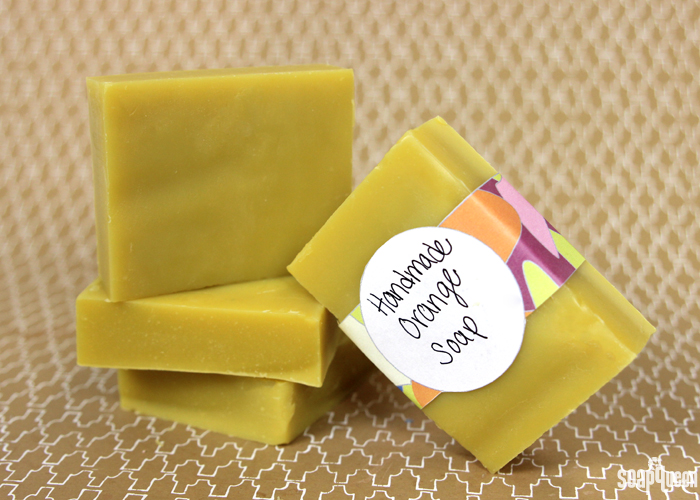
Do you like working with butters in your cold process recipes? Do you have any tips for working with them to share with readers and new soapmakers?
- 13.6 oz. Olive Oil (40%)
- 8.5 oz. Palm Oil (25%)
- 8.5 oz. Coconut Oil (25%)
- 3.4 oz. Cocoa Butter (10%)
- 4.8 oz. Sodium Hydroxide Lye
- 11.2 oz. Distilled Water
- 2 oz. 10X Orange Essential Oil
- Slowly and carefully add the lye to the water and gently stir until the lye has fully dissolved and the liquid is clear. Set aside to cool.
- Combine the coconut oil, olive oil, cocoa butter and palm oil (remember to fully melt then mix your entire container of palm oil before portioning). Allow the lye water and the oils to cool to 130°F or below (and are ideally within 10 degrees of each other). For this recipe, both the oils and lye were around 120°F. If you’d like a harder bar of soap that releases faster from the mold, you can add sodium lactate to the cooled lye water. Use 1 teaspoon of sodium lactate per pound of oils in the recipe. For this recipe, you’d add about 2 tsp. sodium lactate.
- Place your stick blender into the oils. Gently tap the blender on the bottom of the bowl several times to release any bubbles that got trapped by the stick blender head. This is called, “burping the stick blender.”
- Once bubbles no longer rise to the surface of the oils, gently pour the cooled lye water down the shaft of the stick blender and into the oils.
- Turn on the stick blender and pulse several times. You will immediately see the lye and oils begin to come together, and begin to create a creamy yellow color. As you continue to mix, the color will become lighter. Alternate between using the stick blender to stir the mixture, and pulsing the stick blender.
- After about 30 seconds, test for trace. Because this recipe contains 10% cocoa butter, it will begin to thicken quicker than recipes that do not contain butters, or have a high amount of liquid oil. To test for trace, lift the stick blender up and out of the batter, and “drizzle” soap on top. If the drizzles of soap are slightly supported on top of the batter, this is a thin trace. Be sure to also check the sides of the bowl; you want to make sure you see no streaks of oil within the mixture.
- Once you have reached a thin trace, add all the 10X Orange Essential Oil and gently mix in with a whisk. You will notice the color of the soap batter to change into a beautiful orange color immediately.
- Once the essential oil is mixed in, pulse the mixture a few more times with the stick blender until you reach a medium trace. Below, you can see that the soap is fairly thick, and supports itself on top of the mixture. This is a great example of medium trace. For even more examples of trace, check out this blog post.
- Pour the soap into the lined mold, scraping the sides of the bowl with a spatula to get all the soap into the mold. Tap the mold on the counter firmly to help eliminate air bubbles. Make sure you still have your goggles on! Sometimes soap can jump up during this process. =)
- Spray the top of the soap with 99% isopropyl alcohol. Doing so helps to prevent soda ash from forming. Allow the soap to sit in the mold for 3-4 days. Unmold, and cut into bars. Allow the soap to cure for 4-6 weeks. During this time, water evaporates from the soap making it firmer and longer lasting in the shower. The soap can be used before the full cure time, but will not last as long. It’s best to wait!
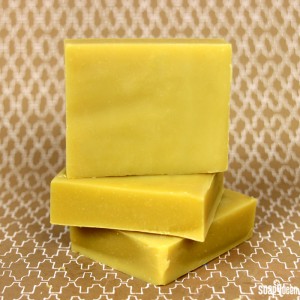



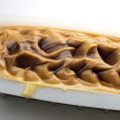
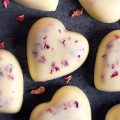
Hi, I use a mask when mixing my lye and water and I even go outside. My question is, do I need to keep the mask on even during the soap making e.i. when mixing my cooled down lye solution with my oils ? Thank you
On another subject, the other day, by mistakes, since I have been doing soap for over a year now, I poured the water in the NAOH instead of the NAOH in the water……and no reaction at all happened other than the regular heating , whitening and then clearing ….you think my lye is expired ?
Thanks a lot.
You can keep the mask on the entire time you soap if you like, some people prefer that. Most of the fumes are released when you add the lye to the water, but there may be a small amount when you make soap as well. Just do whatever makes you feel comfortable.
As long as that lye heated up and acted like normal, it should be fine. How old is it? Also, remember for next time to always add your lye to your water, otherwise it can sometimes boil over!
-Kelsey with Bramble Berry
I made this soap with great success! I would like to use the same oils but use the White Rose fragrance oil (and add colors and do a spoon plop loaf), but I just read that the coco butter could leave a chocolate smell in floral scents. Should I avoid this fragrance, could I just go to the heaviest amount?
The cocoa butter will have a very subtle smell in the finished soap. To be on the safe side, you can use deodorized cocoa butter: https://www.brambleberry.com/Deodorized-Cocoa-Butter-P3199.aspx
It works the same, it just has less scent. 🙂
If you don’t have deodorized cocoa butter on hand, the strong recommendation on the Fragrance Calculator should cover up most of that smell: https://www.brambleberry.com/Pages/Fragrance-Calculator.aspx
-Kelsey with Bramble Berry
White Rose Fragrance Oil: https://www.brambleberry.com/White-Rose-Fragrance-Oil-P6124.aspx
This was my first ever cold process soap. Was I supposed to put it on a heating pad? Also wondered I’d I was to melt all the oils and butters or just the palm oil? I ended up melting them all. Also, the kit did not contain sodium lactate so I will add that in the future. It has been sitting in my mold for 24 hours and I will wait the 3-4 days you recommended before unfolding it. Is there a way to tell when the soap is ready to unmold? Thank you and I’m so looking forward to creating more soap!
Hi Mary! Whether or not you put the soap on the heating pad is up to you. What that does is force gel phase. During gel phase, the soap gets really hot and gelatinous. That helps the color pop a bit more. Some soapers prefer to gel, while others leave their soap at room temperature or put it in the fridge. Either way works, it just depends on what look you’re going for! Read more about when to insulate soap here: http://www.soapqueen.com/bath-and-body-tutorials/tips-and-tricks/when-to-insulate-handmade-soap/
You can tell when the soap is ready to unmold by lightly tapping it. If it’s firm to the touch, pull it out of the box and peel the paper away. If you notice any soft areas, or see that the soap is sticking to the paper, let it sit another day or two. You want it firm enough to unmold and cut cleanly. 🙂
-Kelsey with Bramble Berry
I want to make this soap, I have everything, but Orange essential oil. It is currently out of stock on your website. Which another essential oil or fragrance oil will go with this recipe?
You can use any essential oil you like! Lemongrass or litsea essential oils are great options. They have the bright citrusy notes and stay strong in soap. 🙂
Lemongrass essential oil: https://www.brambleberry.com/Lemongrass-Essential-Oil-P3822.aspx
Listea essential oil: https://www.brambleberry.com/Litsea-Essential-Oil-P3824.aspx
Find all our essential oils here: https://www.brambleberry.com/Essential-Oils-C157.aspx
Certain essential oils do have different usage rates. Find out how much to add with our Fragrance Calculator: https://www.brambleberry.com/Pages/Fragrance-Calculator.aspx
-Kelsey with Bramble Berry
Thanks Kelsey, Fragrance Calculator is really helpful. 🙂
You’re welcome Tejashri! 🙂
-Kelsey with Bramble Berry
Hi there,
I want to try this recipe out but I was wondering if using swapping out the cocoa butter for shea butter instead would be okay? If so, should I use the same amount of shea butter?
Thanks!
You can use shea butter! I would recommend using the same amount. Shea butter is softer than cocoa, so the soap will be a bit softer overall. I would recommend making a small test batch with the substitution. If you like harder bars, you can add more coconut or palm oil. 🙂
Remember to run the recipe through the Lye Calculator after any substitutions: https://www.brambleberry.com/Pages/Lye-Calculator.aspx
This post on substituting oils in cold process soap has some great information as well: http://www.soapqueen.com/bath-and-body-tutorials/tips-and-tricks/how-to-substitute-oil-in-cold-process-recipes/
-Kelsey with Bramble Berry
Shea butter: https://www.brambleberry.com/Shea-Butter-P3220.aspx
Hi,
This has been a very popular bar, people love the texture of it. I would really like to use this recipe to make the Spiced Copper CP tutorial, would I have enough time to do all 5 layers with this recipe do you think before the soap would set up?
Many Thanks
Kate
This recipe would work just fine for the Spiced Copper Cold Process Tutorial! Both this recipe and the Lots of Lather Quick Mix have high levels of hard oils, so they harden up more quickly than softer recipes. That lends itself well to the layers in the copper soap. I would recommend blending until thin trace then splitting into 5 containers. They will continue to thicken as they sit. If you need one a bit thicker before spooning it in, you can give it a quick stir with the stick blender. 🙂
Spiced Copper Cold Process Soap Tutorial: https://www.soapqueen.com/bath-and-body-tutorials/spiced-copper-cold-process-soap-tutorial/
Learn more about thin trace here: http://www.soapqueen.com/bath-and-body-tutorials/tips-and-tricks/trace/
-Kelsey with Bramble Berry
Thanks Kelsey, one more question. I really want to use the Nag Champa fragrance oil. How much Titanium Dioxide would you recommend putting in to stop the spiced copper soap from going brown?
Kate 🙂
Even with quite a bit of titanium dioxide, the fragrance will eventually discolor that chocolatey brown hue. Instead I would recommend embracing it! You can use Gold Sparkle Mica. That will give you a chocolatey brown bar with a sparkly gold mica line. You can also use the Copper Sparkle for a subtle reddish pop in between the layers. 🙂
Nag Champa Fragrance Oil: https://www.brambleberry.com/Nag-Champa-Fragrance-Oil-P3863.aspx
Gold Sparkle Mica: https://www.brambleberry.com/Gold-Sparkle-Mica-P3063.aspx
-Kelsey with Bramble Berry
I tried using this recipe a few times for different batches with different colors and fragrances. They have cured for at least 4 weeks but when I tested in the shower it seemed like the soap made my skin feel tight and a little dry, not soft and moisturized. Is there a reason that might be happening? Is there another recipe that will for sure be a winner?
If you find these bars are a bit drying for your skin, you can add more moisturizing oils! For this recipe, you can increase the olive oil to 50% or so. You can also add another oil like sweet almond or avocado oil. They’re nice and moisturizing. You can decrease the palm or coconut and add up to 15% sweet almond or avocado. Palm and coconut are firm oils that don’t moisturize as much as sweet almond or avocado, so the bars overall will be softer. 🙂
Sweet almond oil: https://www.brambleberry.com/Sweet-Almond-Oil-P3205.aspx
Avocado oil: https://www.brambleberry.com/Avocado-Oil-P3198.aspx
Make sure to run the recipe through the Lye Calculator after any substitutions: http://www.brambleberry.com/Pages/Lye-Calculator.aspx
This post on Formulating Cold Process Recipes has some great information as well: http://www.soapqueen.com/bath-and-body-tutorials/tips-and-tricks/formulating-cold-process-recipes/
-Kelsey with Bramble Berry
Hi Kelsey,
I managed to put 1 photo up on your Facebook page for some reason it wouldn’t let me put up any more than 1. Please when you’ve had a look could you let me know what you think on this page as I don’t really look at Facebook.
Many thanks
Kate:)
You’re welcome Kate! Thanks for posting that picture. 🙂
-Kelsey with Bramble Berry
Hi Kelsey,
I will try to upload photos now – not great with computers!!! I hope you will be able to see whats wrong. I had the soap insulated with a cardboard top, then double wrapped in a towel and on a heat pad, room temp around 18 C as I live in Ireland. However maybe I insulated too much???
Many Thanks
Kate
Sounds good! 🙂
-Kelsey with Bramble Berry
Hi Kelsey,
I cut my orange loaf tonight Wednesday, cdnt wait until thursday. The soap came out of the mould really easily but it was quite soft as I was cutting it, so perhaps waiting another day to cut would have been better. It’s gorgeous and smells divine. My only question is that some of the slices have marks in them very similar to the photos you have of how honey can effect cold process soap. I’m wondering would orange essential oil 10 fold be high in sugar or perhaps was the gel phase too hot? These marks are only really noticeable in a few of the slices, and it does seem to be the darker ones. If it was due to lye not being mixed properly would this not be present in all of the slices? Just wondering???
Many Thanks
Kate 🙂
I’m so glad those bars turned out well! That’s exciting. 🙂
The 10X orange doesn’t usually heat bars up. I’m wondering if it’s something else! If you have a Facebook account, can you message pictures of the bars on our Bramble Berry page? That way I can take a look and see what’s happening!
Bramble Berry Facebook: https://www.facebook.com/BrambleBerry/
-Kelsey with Bramble Berry
Hi Kelsey,
It’s me again. Sorry I checked again and its not black, it just looks like the mica has a bit of moisture in it – I’m assuming from gel phase???
Many thanks
Kate 🙂
Hi Kate!
Sounds like that soap went through gel phase! During gel phase it gets really dark and translucent. You can see another example of that here: http://www.soapqueen.com/bath-and-body-tutorials/tips-and-tricks/when-to-insulate-handmade-soap/
The mica should be just fine. It’s pretty sturdy! How does the loaf look now? 🙂
-Kelsey with Bramble Berry
Hi Kelsey,
It looks amazing I’m so excited I can hardly wait until Thursday. The only thing was I didn’t get the trace thick enough to really pattern the top as I would have liked. I was too worried about over blending so I kept the blender low and used it to stir in between. My trace ended up medium more than thick. I will be trying the lavender ombre soap using the periwinkle lab colour soon so I will have to get it thick for that project. This weekend I’m going to do the hot process lavender and lemongrass which I’m excited about. Also I bought a heat pad which doesn’t seem to get that hot – do they not get very hot? I saw that soap can get bubbles if its too high but when my pad is on medium its really only lukewarm
Many Thanks
Kate 🙂
That’s awesome, I’m glad the soap turned out well! We like using heating pads because they offer a more gentle heat. We like to set it around medium, but if you find yours isn’t very warm you can bump it up to high. Just make sure to watch the soap so it doesn’t get too hot! Then, after about 30 minutes, turn the heating pad off and leave the soap on overnight.
Have fun giving those recipes a try! Let me know how they turn out. 🙂
Layered Lavender Cold Process Soap: https://www.soapqueen.com/bath-and-body-tutorials/back-to-basics-layered-lavender-cold-process-tutorial/
Lavender and Lemongrass Hot Process Soap: https://www.soapqueen.com/bath-and-body-tutorials/lavender-lemongrass-hot-process-soap-on-soap-queen-tv/
-Kelsey with Bramble Berry
Hi Kelsey,
I think it def went through gel phase which I was aiming for. However there is an almost black layer under the mica – can gel phase scorch the mica? The soap is still resting, not due to remove towel until later today, and can’t unmold until Thursday. The waiting is going to kill me!!! I also hope I don’t get air bubbles.
Many Thanks
Kate
Hi Kelsey,
Tried this out today (Sunday) my first ever attempt at soap but I have read and read and watched the videos so I was well prepared. Now I mixed the oils and lye at 120 F and put the mica on top. I then placed at medium on a heat pad for 20 mins then turned heat pad off. Ive been periodically checking and the layer under the mica has gone quite dark – you can see this through the mica and when I lift the mould up I can see a large dark oval shape covering the majority of the bottom of the mould. Do you reckon this is gel phase in action? Also I’m worried now the soap is going to end up brown or something – will it lighten up a bit do you think? Or do you think this dark colour is something else?
Many Thanks Kate
Hi Kelsey,
Sorry would it be okay to put this into loaf mould at thick trace so I can texture the top, and then add the mica?
Many Many Thanks
Kate 🙂
Absolutely! That would look really lovely. Just make sure to give the mold a couple good taps on the counter to release any air bubbles. Then you can texture with a spoon, spatula – anything you like. 🙂
This powder duster is really nice for distributing mica evenly on top of soap: https://www.brambleberry.com/Powder-Duster-P5427.aspx
-Kelsey with Bramble Berry
Thanks so much Kelsey. You are all so lovely!!!
Kate 🙂
You’re very welcome Kate! 🙂
-Kelsey with Bramble Berry
Hi Kelsey,
One more question I’m thinking of adding a dusting of mica on top of this – I’m using the silicone loaf mold. Do I spritz the rubbing alcohol on before the dusting of mica?
Thanks
Kate
Hi Kate,
Oh that will look so pretty! I recommend covering it with the mica first, the spritzing alcohol after. Spritzing with alcohol helps prevent soda ash from forming on top of the soap, but when it’s covered in mica it usually just covers up any soda ash :).
-Amanda with Bramble Berry
Hi,
Just checking if working in a cool kitchen i.e. 16-18 degrees C would we need a heat pad if we want this to go through gel phase – isn’t it correct we want soap to go through gel phase unless its made with milk?
Many Thanks
Kate
Hi Kate!
If your house is on the cooler side, you may need a heating pad and a towel to help that soap go through gel phase! It can also help to soap a little warmer (around 48C for your oils and lye water). Read more about gel phase here: http://www.soapqueen.com/bath-and-body-tutorials/tips-and-tricks/gel-phase/
This post on when to insulate soap is helpful as well: http://www.soapqueen.com/bath-and-body-tutorials/tips-and-tricks/when-to-insulate-handmade-soap/
If your soap contains milk, we recommend keeping it cool instead of warm. Milk can scorch if it gets too hot, which can cause discoloration and an unpleasant smell in the soap. After it’s in the mold, we recommend keeping your soap in the fridge or freezer for 5-24 hours. 🙂
Read more about working with milk here: http://www.soapqueen.com/bath-and-body-tutorials/tips-and-tricks/how-to-add-lye-to-milk-for-cold-process-soap/
-Kelsey with Bramble Berry
I just realized that the lye equation will be different if I use my LouAna’s coconut oil (fractioned oil on the calculator). Is this something that should be mentioned in recipes? I’m new to this so maybe I’m over thinking!! Thanks
Hi Laura!
Fractionated coconut oil and coconut oil to have slightly different lye amounts! When substituting oils, we recommend running your recipe through the Lye Calculator again so you can get the correct lye and liquid amount. 🙂
Lye Calculator: https://www.brambleberry.com/Pages/Lye-Calculator.aspx
This post has more helpful information on substituting oils in cold process recipes: http://www.soapqueen.com/bath-and-body-tutorials/tips-and-tricks/how-to-substitute-oil-in-cold-process-recipes/
Also, because fractionated coconut oil is liquid at room temperature, it will make the recipe a bit softer overall. That means it may take a couple extra days before it’s ready to unmold. If it’s still a bit soft when you’re unmolding, let it sit until it’s firm to the touch. 🙂
-Kelsey with Bramble Berry
Hi, I’m attempting my first batch with this recipe. If I order the soap kit (which includes the ingredients and the mold) can I just use the 10″ silicone mold or do I have to use the box?
Thanks!
Marjorie
Hi Majorie!
You can definitely use the 10″ Silicone Loaf Mold! It works really nicely for soap. Also, this recipe weighs 50 ounces, which is how much the loaf mold holds. That means you don’t need to resize it at all! Nice and easy.
Have fun making your first batch! Let us know how it goes. 🙂
-Kelsey with Bramble Berry
10″ Silicone Loaf Mold: https://www.brambleberry.com/10-Silicone-Loaf-Mold–P5199.aspx
THANK YOU!!! : )-
You’re welcome! 🙂
Can I use 5X orange essential oil instead of 10X?
We didn’t try that in this recipe, but I believe it would be just fine! Because it’s not as concentrated as 10X, it may not be as strong in the final bars. I would recommend a small test batch to see how the scent holds up. 🙂
Learn more about how to prevent scent fading in this post: https://www.soapqueen.com/bath-and-body-tutorials/tips-and-tricks/how-to-prevent-scent-fading-in-soap/
-Kelsey with Bramble Berry
hello my Expert, i have been using fortune buto (it is a vegetable cooking oil in my country, it is light weight oil in type) to make my soap. then i want to add it in this recipe, how can i go about it in terms of measurements (ounces & percentages) to fit this recipe of 24% coconut oil, 44% olive oil, 32% palm oil, 4.8 oz lye, 11.2 oz distilled water, to get a good gentle soap? i will be happy for your help please.
Hi Mukasa!
We haven’t worked with fortune buto before, so I’m not very familiar with it! Is it liquid at room temperature? If so, you can replace some of the olive oil with it. That will make a nice soft soap. If it’s solid at room temperature, you can replace some of the coconut or palm oil with it. A small test batch would be really helpful to see how it feels. 🙂
Read more about formulating cold process recipes here: http://www.soapqueen.com/bath-and-body-tutorials/tips-and-tricks/formulating-cold-process-recipes/
-Kelsey with Bramble Berry
hello, soaping experts! I’m writing in complete anger/frustration/dismay and am hoping you can provide guidance. I have been soaping for a few years now and rely on Soap Queen’s Lots of Lather recipe. The last three times I’ve attempted to soap, the batches don’t trace and end up separating. I haven’t changed my process or ingredients. A few months ago I bought all new oils from Brambleberry (and I use Costco brand olive oil) thinking maybe the oils were bad. Nope – still same effect. I just opened a fresh jar of lye flakes thinking that could be the issue. Yet another bad batch. Since this is the 9th failed batch (I always soap in 3s) I’m amazed at the waste and lack of success. I’ve tripled checked my recipes, lye calculator, process, etc. In lieu of giving up do you have any other suggestions as to why my once many-time successful process is unsuccessful? Any thoughts would be helpful. thank you!
Hi Marilee!
I’m sorry to hear those batches are separating on you! That is definitely frustrating.
I’m wondering if it may be your stick blender. After a lot of use, the stick blenders can start to weaken and not emulsify the soap as well. I would recommend testing your stick blender in a clear container with water to see how fast it pulses. If you notice it’s not very strong, you may want to check the warranty or look into getting a new one. In the meantime, you may need to stick blend your soap longer than you used to in order to get it to emulsify fully.
Let me know how your stick blender test goes!
-Kelsey with Bramble Berry
Thank you for the advice! I plan to do a stick blender test soon (while soaping it was still churning so didn’t appear to have problems but I’ll test against another in case it’s lacking power). I appreciate your response and have hope for the next batch. I love your site and customer service – top notch!
You’re very welcome Marilee, we are happy to help! Let us know how it goes. 🙂
-Kelsey with Bramble Berry
I finally got the courage to try soaping again. Got an industrial strength stick blender and started with the same recipe that has failed the last 4 times but was successful all times before that. Sadly, no trace. I tried stick blending/pulsing for 15 minutes, which I know is excessive but was hoping it would magically work. I use 8 oz olive oil, 8 oz coconut oil, 8 oz palm oil, 1 oz castor, 3.67 oz lye and 8.25 oz water. I’m wondering again if it’s something to do with the oils. The mixture looks grainy. Any additional thoughts? I don’t want to give up indefinitely but I’m close… New recipe, maybe?
Hi Marilee!
Oh no, I’m sorry to hear that! I’m honestly a bit stumped as to why that soap isn’t emulsifying. The soap has some hard oils, which should help it trace faster. Also, stick blenders usually mix that soap up in just a minute or two! What temperatures are you working with? Also, did you switch to a new oil? How old is your lye, and where did you store it?
It is definitely frustrating that the soap isn’t emulsifying. I’ll help you get this figured out so you’ll have nicely emulsified soap. 🙂
-Kelsey with Bramble Berry
Hi Kelsey,
I’m so stumped as well! I think about it ALL the time, trying to understand the failure (especially since I’m out of soap). I’ve checked the lye calculator about 15 times and am measuring everything as directed. The lye is less than a year old (I purchased a new container after thinking my previous lye could have gone bad – same with the oils) and store them in a mud room in my basement (so they all stay consistently cool). The only switch I made was from extra virgin to virgin olive oil (and I went back to EVO this last failed batch). Newer oils, newer lye, new stick blender. My last guess was that maybe my scale was off and that I should try a different scale? I’m just not understanding why a good-to-go recipe and supplies have started consistently failing. My next thoughts were that I should try a premixed bag of oils (Basic or LOL) to see if that’s an issue? Although I don’t think it can be since I’ve reordered. Any insight would be fantastic!
OK, I think I only have one more question! Where did you get the lye from?
-Kelsey with Bramble Berry
Lye (and all other oils, minus olive oil) came from Brambleberry
I have to admit I’m completely stumped. You got sodium hydroxide lye and not potassium hydroxide lye?
-Kelsey with Bramble Berry
OMG Kelsey – THANK YOU! I just checked my type of lye and see that it IS potassium and not sodium. I must not have noticed when ordering the last two bottles and didn’t even know there was a difference til your prompt had me look it up. I’ll be ordering the proper lye from Brambleberry and can be back on my way to soaping successfully! I can’t thank you enough for finding a solution. Big, grateful hugs!!!
Oh good, I was worried we wouldn’t be able to pinpoint the issue! That’s a super easy fix for sure. You’re welcome, have fun making more cold process soap Marilee! 🙂
-Kelsey with Bramble Berry
Hi! I have honey bees and wanted to find a way to use some of the bees wax in my soap! Can I substitute bees wax for the cocoa butter? How would that change the recipe? This recipe calls for 10% cocoa butter but I read in one of your blogs that the recommended amount be no more than 8% beeswax? So I’m not sure how that would change the rest of the recipe? Thanks!
Hi Melody!
You could use beeswax in this recipe rather than cocoa butter if you’d like. You’re correct, a little bit of beeswax in soap goes a long way! We recommend using 3% or less in your soap. In addition, temperature is very important! It’s crucial to soap extremely hot when working with beeswax, or it may cool and harden. We recommend keeping the batter above 140 degrees. Read more about using beeswax in the blog post below :).
Sunday Night Spotlight: Beeswax: http://www.soapqueen.com/bramble-berry-news/sunday-night-spotlight-beeswax/
For this recipe, I would use 3-5% beeswax, and increase the amount of olive oil. This well help keep the batter nice and smooth, while adding more skin loving oils :). You could also increase the palm oil if you prefer an extremely hard bar. I hope this helps!
-Amanda with Bramble Berry
Hi, I can get 10X Orange Essential Oil in Australia, can I use Lemongrass Essential Oil instead? How much should I use? Thanks!
I CAN’T get – woops!
Hi Mandy!
You can definitely use Lemongrass Essential Oil if you like! It would give the soap a citrusy, earthy smell. 🙂
For this recipe, you can add up to 2.5 ounces of lemongrass for a strong scent. You can use our Fragrance Calculator to find out exactly how much to add: https://www.brambleberry.com/Pages/Fragrance-Calculator.aspx
Also, keep in mind Lemongrass Essential Oil doesn’t have the same orange hue as 10X orange, so the color of your soap will be slightly different. It will still look beautiful though! 🙂
-Kelsey with Bramble Berry
Lemongrass Essential Oil: https://www.brambleberry.com/Lemongrass-Essential-Oil-P3822.aspx
My question is do you consider lye water at 128 degrees to be cool enough to add the sodium lactate? I wonder what cool lye water’s temperature is considered. Thank you.
Hi Pam!
Having your lye water at 128F is cool enough for sodium lactate! We typically add sodium lactate right before we get started soaping. At that time, our temperatures are around 120-130F. We don’t recommend adding right after the lye is mixed, as it’s usually as hot as 180-200F. 🙂
-Kelsey with Bramble Berry
Sunday Night Spotlight: Sodium Lactate: http://www.soapqueen.com/bramble-berry-news/sunday-night-spotlight-sodium-lactate/
Orange 10x didn’t hold the scent in my CP soap. I mixed in some kaolin clay to try and make it stick, but it didn’t help.
The Orange Peel FO is the only thing I have found that really works nicely if you are wanting orange fragrance for CP.
Hi Jill!
Hmm, that’s strange! In our tests and recipes, we’ve found that 10X Orange lasts very well in cold process soap. How much essential oil are you adding to the batch? You can add up to .8 ounces of essential oil per pound of cold process soap for a nice strong scent that lasts. 🙂
Orange Peel Cybilla Fragrance Oil smells great as well!
Orange Peel Cybilla Fragrance Oil: https://www.brambleberry.com/Orange-Peel-Cybilla-Fragrance-Oil-P3391.aspx
-Kelsey with Bramble Berry
Fragrance Calculator: https://www.brambleberry.com/Pages/Fragrance-Calculator.aspx
I always add some sort of butters to my soap. I melt my butters separately from my oils and then combine them, I measure them in separate containers anyway. The butters take longer to melt down, particularly hard ones like cocoa and I don’t want to heat up my oils enough to melt it in. I can melt on short bursts, as in doing melt and pour, in order to avoid overheating the container. It creates an additional oily container to wash, but It works well for me.
Those are great tips! Butters can get grainy if they’re heated too much or too fast. Melting them separately ensures they don’t get too hot. 🙂
-Kelsey with Bramble Berry
Soaping in the Summer Heat: http://www.soapqueen.com/bath-and-body-tutorials/tips-and-tricks/soaping-in-the-summer-heat/